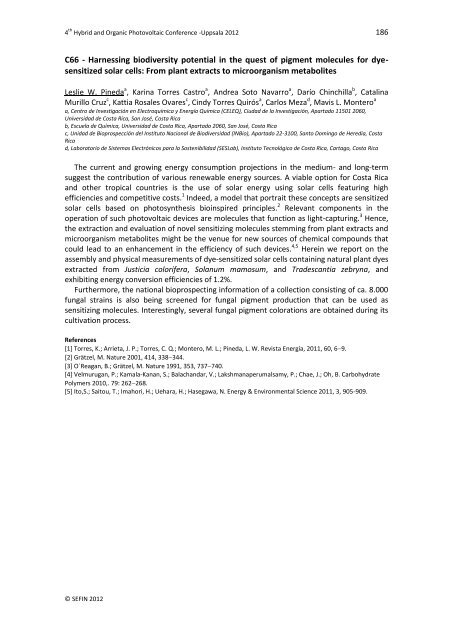HOPV12 - Blogs
HOPV12 - Blogs
HOPV12 - Blogs
Create successful ePaper yourself
Turn your PDF publications into a flip-book with our unique Google optimized e-Paper software.
4 th Hybrid and Organic Photovoltaic Conference -Uppsala 2012 186<br />
C66 - Harnessing biodiversity potential in the quest of pigment molecules for dyesensitized<br />
solar cells: From plant extracts to microorganism metabolites<br />
Leslie W. Pineda a , Karina Torres Castro a , Andrea Soto Navarro a , Darío Chinchilla b , Catalina<br />
Murillo Cruz c , Kattia Rosales Ovares c , Cindy Torres Quirós a , Carlos Meza d , Mavis L. Montero a<br />
a, Centro de Investigación en Electroquímica y Energía Química (CELEQ), Ciudad de la Investigación, Apartado 11501 2060,<br />
Universidad de Costa Rica, San José, Costa Rica<br />
b, Escuela de Química, Universidad de Costa Rica, Apartado 2060, San José, Costa Rica<br />
c, Unidad de Bioprospección del Instituto Nacional de Biodiversidad (INBio), Apartado 22-3100, Santo Domingo de Heredia, Costa<br />
Rica<br />
d, Laboratorio de Sistemas Electrónicos para la Sostenibilidad (SESLab), Instituto Tecnológico de Costa Rica, Cartago, Costa Rica<br />
The current and growing energy consumption projections in the medium- and long-term<br />
suggest the contribution of various renewable energy sources. A viable option for Costa Rica<br />
and other tropical countries is the use of solar energy using solar cells featuring high<br />
efficiencies and competitive costs. 1 Indeed, a model that portrait these concepts are sensitized<br />
solar cells based on photosynthesis bioinspired principles. 2 Relevant components in the<br />
operation of such photovoltaic devices are molecules that function as light-capturing. 3 Hence,<br />
the extraction and evaluation of novel sensitizing molecules stemming from plant extracts and<br />
microorganism metabolites might be the venue for new sources of chemical compounds that<br />
could lead to an enhancement in the efficiency of such devices. 4,5 Herein we report on the<br />
assembly and physical measurements of dye-sensitized solar cells containing natural plant dyes<br />
extracted from Justicia colorífera, Solanum mamosum, and Tradescantia zebryna, and<br />
exhibiting energy conversion efficiencies of 1.2%.<br />
Furthermore, the national bioprospecting information of a collection consisting of ca. 8.000<br />
fungal strains is also being screened for fungal pigment production that can be used as<br />
sensitizing molecules. Interestingly, several fungal pigment colorations are obtained during its<br />
cultivation process.<br />
References<br />
[1] Torres, K.; Arrieta, J. P.; Torres, C. Q.; Montero, M. L.; Pineda, L. W. Revista Energía, 2011, 60, 6�9.<br />
[2] Grätzel, M. Nature 2001, 414, 338�344.<br />
[3] O´Reagan, B.; Grätzel, M. Nature 1991, 353, 737�740.<br />
[4] Velmurugan, P.; Kamala-Kanan, S.; Balachandar, V.; Lakshmanaperumalsamy, P.; Chae, J.; Oh, B. Carbohydrate<br />
Polymers 2010,. 79: 262�268.<br />
[5] Ito,S.; Saitou, T.; Imahori, H.; Uehara, H.; Hasegawa, N. Energy & Environmental Science 2011, 3, 905-909.<br />
© SEFIN 2012


